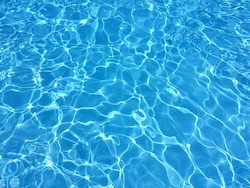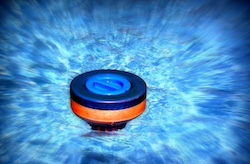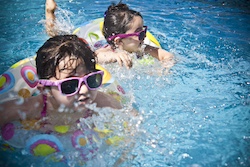1.800.858.7378 npic@ace.orst.edu
We're open from 8:00AM to 12:00PM Pacific Time, Mon-Fri
About us
1.800.858.7378 npic@ace.orst.edu
We're open from 8:00AM to 12:00PM Pacific Time, Mon-Fri
About us


Pool chemicals are used to maintain swimming pools and spas to reduce germs and other microorganisms in the water and keep the pool looking clean. These products include sanitizers, algaecides, pH balancers, clarifiers, and shock.1 Pool chemicals are an important tool to protect the health of swimmers. Antimicrobials such as chlorine and bromine kill bacteria that can cause recreational water illnesses. Maintaining the proper level of these chemicals and proper water pH helps to kill bacteria and reduce irritation to swimmers.2
This fact sheet focuses on pool products that kill bacteria and and other microorganisms in swimming pools and spas. See NPIC's fact sheet about antimicrobials for general information.
This fact sheet refers to the technical grade, or "pure" chemical of each active ingredient. Pool products you buy from the store usually include other ingredients as well. While many of the chemicals used as other ingredients may not pose health or environmental risks, some of them can be toxic. In some cases, the other ingredients can pose greater risks than the active ingredients themselves.
Products that claim to prevent, remove, or otherwise control algae, bacteria, and other human pathogens are considered antimicrobial pesticides. These products require registration with the U.S. EPA.3 Their product labels include an EPA registration number. Examples of label claims on pesticide pool products include:
If the label does not state that the product prevents, removes, or otherwise controls these microorganisms, it is not intended to kill germs, and is not regulated as a pesticide.3 Examples of non-pesticide label claims may include:
Antimicrobial pool products kill or slow the spread of microorganisms, such as bacteria, algae and viruses. They are sold as powders, tablets, and liquids. Each product may have a different mixture of active and other ingredients. Some examples of active ingredients commonly found in antimicrobial pool chemicals are:

Pool chemicals are designed for use in specific ways. Only use your product as described on the label. Following the precautions and the tips below can help minimize your risk. Always read the label before you buy a product and make sure it is meant for your specific use.
All chemicals, including pool chemicals, have some level of toxicity. The toxicity depends on the specific product and route of exposure (swallowing, breathing, or touching). Each product has a signal word on its label describing the acute, or short-term, toxicity of the mixture in the bottle.
Pool chemicals can cause injury if they get onto the skin or eyes, or if they are inhaled or ingested.5 Most pool chemicals are irritating or corrosive if they get on the skin or in the eyes.6-10 Skin sensitization is an allergic reaction after repeated contact with a substance. Researchers found that PHMB can act as a skin sensitizer.8 Some animal testing showed halohydantoins to be skin sensitizers while others did not.10
The risk of exposure is highest when mixing and applying. Consider taking the precautions listed above and always follow the label to reduce risk of exposure. If anyone is exposed, follow the First Aid instructions on the product label carefully. For additional treatment advice, contact the Poison Control Center at 1-800-222-1222.
| Table 1: Acute toxicity of active ingredients commonly found in pool chemicals | |||||
|---|---|---|---|---|---|
| Sodium and Calcium Hypochlorite salts6,11 | *Chlorinated isocyanurates7 | **Halohydantoins10 | Polyhexamethylene biguanide (PHMB)8 | Sodium bromide9 | |
| Acute Oral | Low to very low toxicity | Low toxicity | Moderate to very low toxicity | Low toxicity | Low toxicity |
| Acute Inhalation | Calcium hypochlorite - low toxicity | Testing not required | Moderate toxicity | Low toxicity | Study not available |
| Acute Dermal | Moderate toxicity | Low toxicity | Low to very low toxicity | Low to very low toxicity | Low toxicity |
| Primary Eye | Corrosive | Corrosive | Corrosive | Moderate to corrosive irritant | Mild irritant |
| Primary Skin | Corrosive | Mild irritant | Corrosive | Slight to moderate irritant | Low toxicity |
|
*Chlorinated isocyanurates include five chemicals: dichloro-s-triazinetrione, potassium dichloro-s-triazinetrione, sodium dichloro-s-triazinetrione, trichloro-s-triazinetrione, and sodium dichloro-s-triazinetrione dihydrate. These chemicals react to form isocyanuric and cyanuric acid, which slow the breakdown of chlorine in sunlight.7 **Halohydantoins include the active ingredients dichlorodimethylhydantoin, bromochlorodimethylhydantoin, dichloroethylmethylhydantoin, dibromodimethylhydantoin, and bromochlorodimethylhydantoin. After applying to water, these chemicals break down and release chlorine and/or bromine which react with water to form hypochlorous acid or hypobromous acid. These are the chemicals that function as antimicrobials.10 |
|||||

Chlorine is a gas used to make disinfectants like bleach (sodium hypochlorite) and other swimming pool chemicals. Pool chemicals do not always release chlorine gas. However, they can do so, especially if they are used improperly. When inhaled, chlorine is irritating to the eyes, nose, and throat. Inhaling chlorine gas can cause coughing and lung damage.12
Chlorine can lead to the development of chloramines. Chloramines can cause health effects in swimmers such as skin and eye irritation. They can also cause coughing, wheezing, and asthma attacks in sensitive individuals.13 They form because of the reaction between chlorine and other substances, including water. When pool chemicals containing chlorine are added to water, the chlorine dissolves to form hypochlorous acid and hypochlorite anion, which disinfect the water.14 The hypochlorous acid and hypochlorite ions can combine with organic waste products such as dirt, cosmetics, urine, feces, and sweat to form chloramines.15 Chloramines off-gas from the water. They are heavier than air and tend to build up in the air above and surrounding pool water. This could expose swimmers and others in the area. Chloramines may build up to high levels in indoor pools without good ventilation.13
Like any chemical, pool chemicals have different risks of contributing to cancer, depending on the specific chemical. See our fact sheet "Can pesticides cause cancer?" for more information about cancer classifications and determining cancer risk.
| Table 2: Carcinogenicity of pool chemicals | |
|---|---|
| Active Ingredient | Cancer Classification |
| Hypochlorite salts (includes sodium and calcium hypochlorite) | *Not classifiable17 Can form trihalomethanes which are possible carcinogens18 |
| Chlorinated isocyanurates | *No carcinogenic effects or not classifiable7,19 |
| Halohydantoins | No evidence of carcinogenicity10 |
| Polyhexamethylene biguanide (PHMB) | *Not classifiable8 |
| Sodium bromide | Can form bromate, a known carcinogen9,20 |
| *When scientists don't have enough data to determine if certain chemicals can cause cancer the chemicals are classified by authoritative bodies as "not classifiable." | |

Many pool products are very reactive chemicals. Use care to store and dispose of them properly. Always follow any storage instructions on the product label, along with these tips:5
Sodium hypochlorite and calcium hypochlorite break down very quickly. When exposed to oxygen they react with organic matter and convert into sodium chloride (table salt) and calcium chloride (road salt).6
Pool chemicals and treated pool water often contain high levels of chlorine, or other antimicrobial ingredients. The treated water can harm fish and other aquatic life if discharged in a way that allows it to reach surface water. Discharging pool water onto the ground may damage plants and animals and may drain to streams or ponds.21
Before discharging, consider contacting your local wastewater service provider, water authority, city government, or state environmental agency for guidance. Precautions may be required. These can include holding the water to reduce product concentration, ensuring the water stays on your property, and taking care to prevent the creation of odors or potential mosquito breeding grounds.21 Best practices for discharging your pool water can vary depending on your community. If you have questions, contact your state environmental agency.
For more detailed information about pool chemicals, please visit the list of referenced resources below or call the National Pesticide Information Center, Monday - Friday, 8:00am - 12:00pm Pacific Time (11:00am - 3:00pm Eastern Time) at 800-858-7378. NPIC provides objective, science-based answers to questions about pesticides.
Please cite as: Foss, C.; Gervais, J.; Cross, A.; Cocks, M.; Mermer, S. 2024. Pool and Spa Chemicals Fact Sheet; Oregon State University Extension, National Pesticide Information Center, Oregon State University Extension Services. http://npic.orst.edu/factsheets/pool-chemicals.html

NPIC fact sheets are designed to answer questions that are commonly asked by the general public about pesticides that are regulated by the U.S. Environmental Protection Agency (U.S. EPA). This document is intended to be educational in nature and helpful to consumers for making decisions about pesticide use.